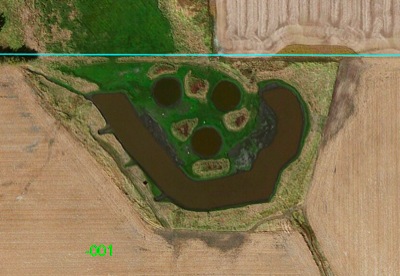Saturday, August 22nd, 2015
County residents happy to stem the tide of disappearing wetlands
By Nancy Allen

Submitted Photo
This wetland is located at U.S. 127 and Sites Road in Hopewell Township on land owned by Gary Gross. By complete happenstance, the wetland designed by Mercer County Soil and Water Conservation District technician Matt Heckler, came out shaped like a smiley face with a toothy grin.
When Gary Gross thinks of the wetland on his property at U.S. 127 and Sites Road in Hopewell Township, he smiles.
"When Matt laid it all out and proposed it to me, he showed me a CAD drawing before it was installed and I said, 'Hey, it looks like a smiley face.'"
Matt Heckler, a Mercer County Soil and Water Conservation District technician, designs wetlands for county landowners. He said Gross' plan originally called for excavating a lot more dirt from the area, but unstable muck ground that could swallow up heavy machinery made that impossible. The soil types on Gross' land lent themselves to digging in certain areas which resulted in that specific shape, Heckler explained.
The wetland was built in 2008 using a government program that pays landowners to take land out of agricultural production. Other similar government programs exist that pay to create new or enhance existing wetlands, Heckler said.
Called nature's kidneys for their ability to filter out impurities and excess nutrients in water, much of the wetlands in the U.S. have disappeared over the years due to development and farming.
Heckler said the reasons people decide to install wetlands varies. Chiefly people want a natural area upon which to hunt and enjoy with family close to home. Other reasons are that the land is flood-prone and not guaranteed to produce a crop every year or because the area is too small to farm, he said.
Gross said he decided to build his because the farm ground it covered flooded. Gross said the previous owner had put the land in a government conservation program that paid the owner to plant grasses. After purchasing the land, Gross wanted to enhance it by building the wetland on it.
"I liked that idea because I like to duck hunt," he said, adding that wetlands attract various waterfowl and shorebirds.
In all, Gross owns 78 acres in the area, nine of which contain the wetland, 11 acres of existing woods and nine acres of 3,000 recently planted hardwood trees.
Gross said wetlands help improve water quality and provide habitat for wildlife.
Heckler said wetland construction in the county has been been good during the last several years, with 11 built in 2010 at 33.1 acres, seven in 2011 at 18.7 acres, three in 2012 at 11.3 acres, six in 2013 at 65.7 acres and five in 2014 at 39. So far this year the SWCD has installed three wetlands in the county totaling almost 61 acres and plans to install three more totaling 35 acres.
Fort Recovery resident Gary Steinbrunner considers himself a conservationist. He has had four wetlands constructed on his property in Recovery Township south of St. Joe.
Steinbrunner said the main reasons he built his wetlands was to create habitat for wildlife and to improve the quality of water that leaves his land.
One of the wetlands Steinbrunner built treats wastewater from his private septic system.
"So instead of flowing into a leach bed it flows into a wetland and the plants use up all the nutrients and then the clean water flows out of the wetland into a stream," he explained.
Another one of Steinbrunner's wetlands is basically an area where a dike was built and the land flooded. Water control structures allow him to flood the area in the fall and winter months and release water in the spring and summer. The acreage is used to grow timber and also provides a resting place for migratory waterfowl, he said. His other two wetlands he built mostly to provide wildlife habitat and improve water quality by filtering runoff, he said.
"What I tell people is wetlands are the kidneys of the earth and filter out all the chemicals and impurities you don't want floating downstream and don't want in your drinking water."
Ken Werling built two wetlands on his property at the corner of state Routes 29 and 118. The 6-acre wetland he built to keep runoff from nearby farmland from entering an existing pond on his property. A smaller half-acre wetland he built to catch the overflow from his pond when it gets too full.
He also planted several types of native grasses and wildflowers and 1,000 hardwood trees around the wetlands.
"A couple of months ago when you looked out at the field it was almost completely yellow with wildflowers," he said. "And every year something new comes up."
The area attracts lots of wildlife while he enjoys watching. He puts out feeders for whitetail deer and has seen bald eagles and other animals on the property.
But he's not against hunting.
"I have hunted all over North America, so I am not anti-hunter or anti-gun," he said. "The animals use it for preservation, but at the same time if the animals get off my land, anyone can hunt and it's fair game."
Maintaining the area is a lot of work, but well worth it, he said.
"The thing we've got to watch out the most out there is to keep the aggravating weeds out like fescue and thistles," he said. "We got to control those."
Werling's land is the site of a Sept. 12 wetland habitat workshop. It was chosen, Werling said, because it is so well maintained.
"The guy from Columbus who's helping with this said he's never seen one so well maintained," Werling said.
For more information on wetlands, contact the Mercer County Soil and Water Conservation District at 419-586-3289.
Wetlands workshop:
WHAT: Wetland habitat workshop focusing on construction and management of wetlands
WHEN: Sept. 12, 8:30 a.m. to 3 p.m.
WHERE: Mercer County Central Services Building in Celina followed by viewing wetlands at the Ken Werling property located at the corner of state Routes 29 and 118.
COST: $10 per person
SIGNUP DEADLINE: Sept. 4 by calling the Mercer SWCD office at 419-586-3289.

